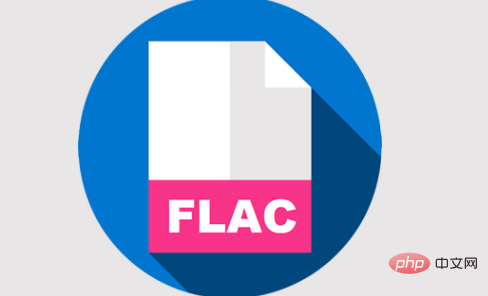Home >Common Problem >What encoding format is flac?
What encoding format is flac?
- 青灯夜游Original
- 2023-02-21 16:46:133111browse
FLAC is a lossless audio compression encoding and a digital music file format; unlike other lossy compression encodings such as MP3 and AAC, it does not destroy any original audio information, so music can be restored CD sound quality. FLAC is lossless compression, which means that no information will be lost after the audio is compressed with FLAC encoding. After the FLAC file is restored to a WAV file, the content will be the same as the WAV file before compression.

The operating environment of this tutorial: Windows 7 system, Dell G3 computer.
flac is one of the currently popular digital music file formats.
FLAC (Free Lossless Audio Codec), Chinese can be interpreted as lossless audio compression coding.
FLAC is a well-known set of free audio compression codes, which is characterized by lossless compression. Unlike other lossy compression codes such as MP3 and AAC, it does not destroy any original audio information, so it can restore the sound quality of music discs.

FLAC is free and supports most operating systems, including Windows, systems developed based on Unix Like kernels (Linux, BSD, Solaris, IRIX, AIX, etc.) , BeOS, OS/2, Amiga. And FLAC provides a build system on the development tools autotools, MSVC, Watcom C, and Project Builder.
Features
Lossless compression: The encoded audio (PCM) data does not have any information loss, and the decoded output audio is consistent with the encoder's Every byte of input is the same. Each data frame has a 16-bit CRC check code of the current frame, which is used to monitor data transmission errors. For the entire audio data, an MD5 tag for the original uncompressed audio data is also stored in the file header, which is used to verify the data during decoding and testing. When a computer plays a WAV file, it sends the PCM data in the WAV file directly to the sound card. When the computer plays FLAC, it needs to first decode the FLAC into PCM data and then send it to the sound card. It just adds a decoding link, just like decompressing a RAR file. The PCM data is no different from the WAV before compression.
Fast: FLAC pays more attention to the speed of decoding. Decoding only requires integer operations and has very low computational speed requirements compared to most encoding methods. Real-time decoding can be easily achieved on very common hardware.
Hardware support: Because FLAC provides free decoding examples and has low decoding complexity, FLAC was the only lossless compression encoding with widespread and good hardware support until 2012.
Can be used for streaming media: Each data frame of FLAC contains all the information required for decoding. The current frame is decoded without reference to the data frames preceding or following it. FLAC uses a synchronization code and CRC (similar to encoding formats such as MPEG) so that the decoder can have minimal time delay when positioning jumps in the data stream.
Can be positioned: FLAC supports fast sampling and precise positioning. This is not only beneficial for playback, but also makes FLAC files easier to edit.
Flexible metadata: New types of metadata data blocks can be defined and implemented without affecting the use of old data streams and decoders. Existing metadata types include tags, cue tables, and positioning tables. Registered applications can define their own dedicated metadata types (Annotation: This is similar to the MIDI standard).
Ideal for archiving applications: FLAC is an open encoding format, and without any data loss, you can convert it to any other format you need. In addition to the CRC and MD5 tags of each data frame to ensure data integrity, flac (Annotation: the command line encoding tool provided by the FLAC project) also provides a verify option when using this option for encoding. , while encoding, the encoded data will be decoded immediately and compared with the original input data. Once a difference is found, it will exit and give an alarm.
Facilitates backing up CDs: FLAC has a "CUE table" metadata data block used to save the CD's content list and the index points of all audio tracks. You can save a CD to a single file and import the CD's cue table, so that a FLAC file can completely record all the information of the entire CD. In other words, you can embed CUE files that are usually stored separately into FLAC in the file. When your original CD is damaged, you can use this file to restore an exact copy of the CD.
Anti-damage: Due to the frame structure of FLAC, once the data stream is damaged, the loss will be limited to the damaged data frame. Usually only a short fragment is lost. When many other lossless audio compression formats encounter damage, one damage will cause the loss of all subsequent data.

Expand knowledge: analyze the difference
FLAC is different from MP3. MP3 is a lossy audio compression encoding, but FLAC is a lossless compression, which means that no information will be lost after the audio is compressed with FLAC encoding. After the FLAC file is restored to a WAV file, the content will be the same as the WAV file before compression.
This compression method is similar to ZIP, but the compression rate of FLAC is greater than ZIP and RAR, because FLAC is a compression method specially designed for the characteristics of PCM audio.
And you can use the player to play FLAC compressed files directly, just like you usually play MP3 files (there are already many car players and home audio equipment that support FLAC, you can find these equipment manufacturers on the FLAC website the link to).
For more related knowledge, please visit the FAQ column!
The above is the detailed content of What encoding format is flac?. For more information, please follow other related articles on the PHP Chinese website!

